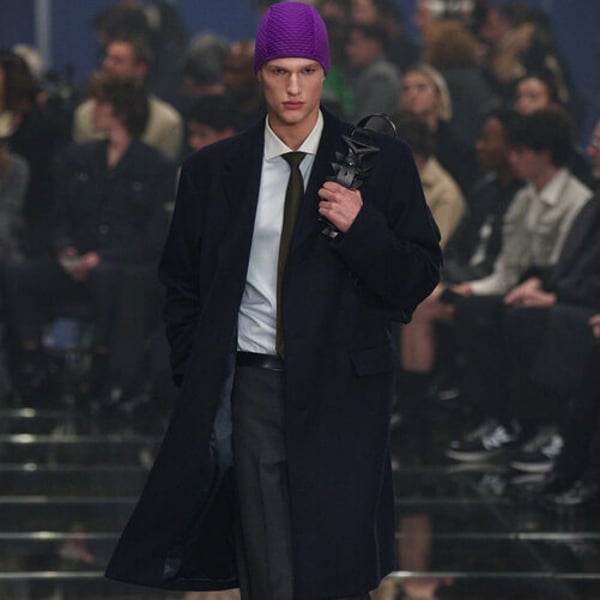“If we were a cooking show, we'd be talking about Teflon-coated pans right now,” said Steve McCullough, event director of Functional Fabric Fair, He added: “That's what most people think of when they think of PFAS.”
McCullough was referring to perfluoroalkyl and polyfluoroalkyl chemicals, commonly known as PFAS. Starting January 1, 2025, the sale and distribution of clothing and textile products containing PFAS will be illegal in New York and California.
Since its primary function is to repel water, resist oil and stains and even be fire retardant, it is a hot topic among exhibitors and attendees at the trade show aimed at brands that produce outdoor gear and technical apparel.
Ammi Borenstein, founder and director of Snaplinc Consulting, which advises brands on sustainability strategies and ESG support, spoke on the topic to show attendees who will need to adapt to and comply with the new laws. FashionNetwork.com attended the fair to better understand the new legislation.
Borenstein’s discussion began with a real-time, interactive poll to address the issue; from what the name evokes, to awareness of the law and how to comply with it. The chemicals, which are commonly known as PFO8, C8 and C6, are known to have been used in clothing since the 1950s, but have been the subject of new legislation because their chemical toxicity is believed to have always caused cancer.
New York State initially passed a law in 2023 banning the chemicals in regular-wear and formal clothing but expanded it to outdoor clothing for enforcement beginning in January 2025, with an even greater distinction for severe weather, which will be affected by the ban beginning in January 2028. California’s AB 1817 law bans the sale of any textile; thus, it covers shoes, leather goods, and clothing and includes components such as zippers, buttons, or other hardware. Borenstein also noted that California has a new law in the works, California AB 347, that will expand the language to require brands to test products, register them, and face stiff penalties for noncompliance.
New York’s law currently includes stiff penalties. Borenstein noted that since testing a garment costs just $115, it could be a fruitful way for state officials to cover budgetary needs by randomly testing garments and imposing fines on those that fail. The United States leads the way in the European Union, which has yet to enact such laws. Coincidentally, leather contains PFAS, and European luxury brands rely on the ability to produce and sell them. Borenstein’s agency understands that the luxury fashion industry needs to stay on top of the new legislation, and that several large, well-known brands have reached out to Snaplinc to organize compliance strategies.

Borenstein stressed that audiences should be aware that brands will have the burden of proof on whether products for sale are PFAS-free or meet acceptable total organic fluoride parameters, which are currently below 100 parts per million (though they could be adjusted to lower parts per million in the future).
Brands will have to prepare Certificates of Compliance, which retailers will require to prove their products are PFAS-free. So testing labs like Intertek and SBS are poised to ramp up their activity. She noted that big players in the outdoor apparel industry — REI, Dick's Sporting Goods and BackCountry.com — are already requiring them. A major concern for brands is what to do with existing inventory, which can currently be sold in the other 48 states, but at least 20 more states will follow California and New York with PFAS bans.
Even though brands have been working on this issue for several years (one exhibitor at the fair told FashionNetwork.com that the 2019 film 'Dark Waters', inspired by the events that exposed industrial giant Dupont's complicity in chemical toxicity, highlighted the problem for the textile and apparel industry), with the constant flow of products associated with the apparel industry, it is no easy task. There is also the arduous task of complying with EPA requirements, which basically require brands to report products made with PFAS since 2011. Companies will have until May 2025 to comply, and smaller companies until November 2025.
Marco Weichert, executive director of Performance Days, a Germany-based textile trade show that runs alongside the Functional Fabric Fair, said the good news is that alternatives to chemicals have been discovered — essentially with one caveat.
“The entire market will fall in terms of water repellency, and the consumer will notice. The new normal is that jackets get wet. To revive functionality, garments need to be washed more frequently, which is less sustainable. We see brands stepping in to offer dry cleaning and seasonal product enhancements. Oil repellency is where it will be noticed – body oil is enough to damage the garment and think about how many times you touch the garment at retail,” Weichert suggested.
One outdoor footwear brand, Keen, is no stranger to the process since it introduced a voluntary phase-out in 2014. The process included a supply chain audit and a review of where PFAS were being used in unneeded products (in the straps of a sandal), which eliminated 65 percent. They eventually found alternatives to PFAS for the other 35 percent of products, which were PFAS-free by 2018. Packaging followed in 2022. It wasn’t cheap — the brand spent $1 million to achieve it.

Kirsten Blackburn, Keen's Sustainability DirectorThey said they happily shared the information with their colleagues, much of which is on their website.“We have published our Green Paper, a roadmap for other brands to eliminate PFAS from their supply chains. We didn't want to be part of the problem and now we want to be part of the solution,” she said.
She advises that brands should work closely with their suppliers to avoid unwittingly sourcing chemicals, creating a restricted chemicals list and policy and being prepared for the long road to eliminating the chemical's lingering presence.
“Achieving PFAS-free production requires commitment from across the value chain. Not every company has the budget or resources to dedicate a person or department to this task. However, until we all take action to eliminate PFAS from our shared supply chain, these toxic chemicals will continue to bioaccumulate,” she added.
Copyright © 2024 FashionNetwork.com All rights reserved.











